Unfortunately, the rose is often afflicted by diseases and pests. We show how to recognize the symptoms of the disease and fight them with natural remedies.

roses (pink) have high demands on their location and maintenance. If something isn't right, even the sturdiest variety of roses can get sick. Black spots or a whitish coating on the leaves are often the first indication of a fungal disease. But some pests are also very fond of the queen of flowers. Aphids, cicadas and the like multiply quickly and can sometimes cause serious damage to the roses. In order for your rose to remain healthy and produce many beautiful flowers, it is important to react promptly and correctly. In this article, we will explain how you can recognize and successfully combat diseases and pests on roses.
contents
-
The most common rose diseases
- Recognize and fight blackspot on roses
- Identify, prevent and combat powdery mildew on roses
- Recognizing and combating rose rust
- Recognizing and combating chlorosis on roses
-
The most common pests of roses
- Fight rose aphids
- Identify and control rose sawfly
- Recognizing and combating rosehoppers
- Recognize and combat rose leaf roller wasps
- Identify and control rose gall wasp
The most common rose diseases
In humid conditions, fungal diseases often afflict roses. Discoloration of the leaves can in turn indicate a nutrient deficiency. Using a few examples, we will explain to you how you can recognize and successfully combat rose diseases.
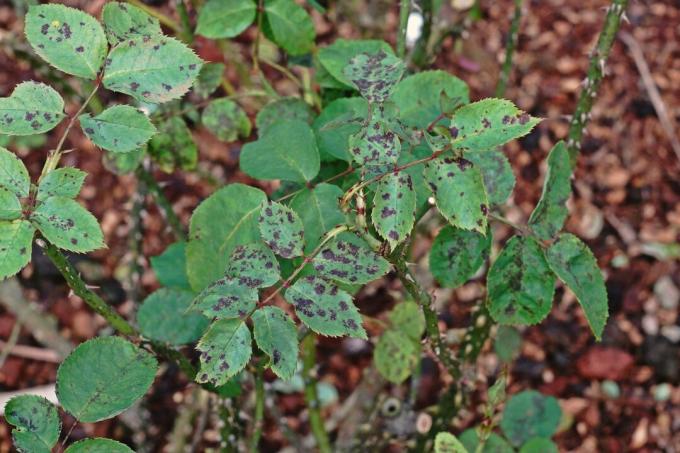
Recognize and fight blackspot on roses
If you see gray-black spots combined with yellowish discolouration on the leaves of your rose, it is probably an infection with blackspot, which is also known as black spot disease. This common fungal disease occurs only in roses. The causative sac fungus Diplocarpon rosae multiplies particularly quickly in wet weather with temperatures above 15 °C. Individual infested leaves and plant parts should therefore be removed as quickly as possible and disposed of in the residual waste. You can treat heavily infested roses with a fungicide so that the plants do not lose all their foliage. As Identify and fight blackspot as well as prevent this, we explain in detail in our special article.

Identify, prevent and combat powdery mildew on roses
Two different fungal diseases are colloquially referred to as powdery mildew. The powdery mildew on the rose (Podosphaera pannosa) can be recognized by its typical mealy coating on the upper side of the leaf as well as on the shoots and buds. Downy mildew fungi (downy mildew) in turn form dark purple spots and lead to rapid leaf fall. In both cases, you should react quickly to avoid further spread.

Various plant protection products for the treatment of powdery mildew and downy mildew are available in specialist shops. You can also use household remedies such as milk or baking powder to combat powdery mildew. When buying new roses, the choice of variety can also make a significant contribution to the prevention of fungal diseases. We advise you to look out for resistant varieties to reduce the need for crop protection products. If a rose has been awarded the General German Rose Novelty Test (ADR), you can be sure that this rose is resistant to fungal diseases. More tips like you Recognizing and combating powdery mildew on roses we have put together a special article for you.

Recognizing and combating rose rust
You can recognize the infestation with rose rust by the yellow-red spots on the upper side of the leaf. Later, yellow-orange pustules the size of a pin appear on the underside of the leaves, which represent the spore deposits of the pathogen. To avoid spreading, be sure to remove fallen foliage from under the rose in the fall. But a sunny, airy location also helps to prevent fungal diseases. In our article on rose rust, we provide you with further measures for effective Combating rose rust in front.
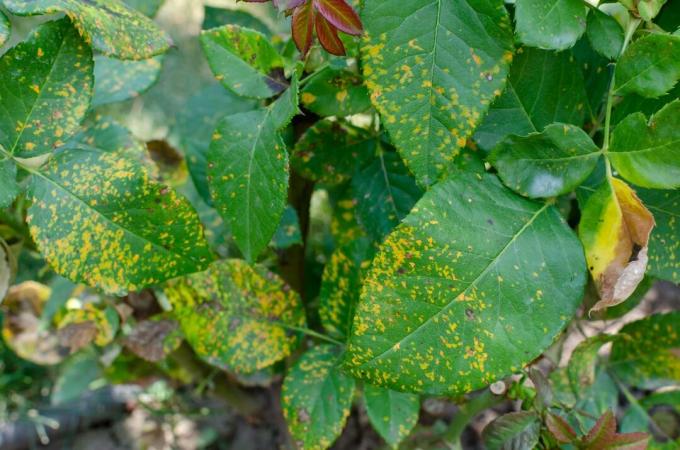
Recognizing and combating chlorosis on roses
Chlorosis is a lack of the green pigment chlorophyll, which causes the leaf to lighten and turn yellow. The reasons for this can be very diverse. Since chlorophyll is vital for the plant, you should react quickly at the first sign of chlorosis. A calcium, nitrogen, magnesium, boron or iron deficiency, for example, leads to yellowing of the leaves. Finding the right cause is sometimes not easy, especially because the deficiency is not necessarily gone Fertilization can be corrected, for example if the soil has an incorrect pH value or there is a nutrient imbalance gives. However, these are rather special cases. If the leaves of your potted rose show chlorosis, adding a fertilizer usually helps to compensate for the lack of nutrients. However, over-fertilization can also lead to chlorosis. What you against yellow leaves as a sign of chlorosis we can explain to you in detail in our special article.
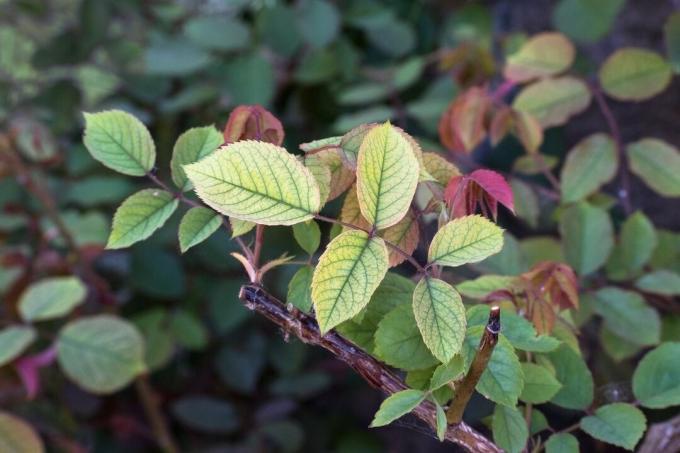
by the way: The best way to prevent a deficiency caused by improper pH or nutrient imbalances in the soil is to simply use a predominantly organic fertilizer like ours Plantura organic rose fertilizer. This does not affect the pH value and contains all relevant nutrients in the right ratio.
The most common pests of roses
Unfortunately, roses are not immune to pest infestation. The sucking and eating damage caused by the small crawling creatures and their larvae can be quite a problem for the plants. In the following, we explain how you can locate the culprits and fight them successfully.
Fight rose aphids
The rose aphid (Macrosiphum rosae) is one of the best-known parasites on roses. It is about the size of a pinhead and comes in the color variants green or yellowish-red. The rose aphid prefers to sit on young shoots and buds, sucking on the sugary phloem sap of the rose.
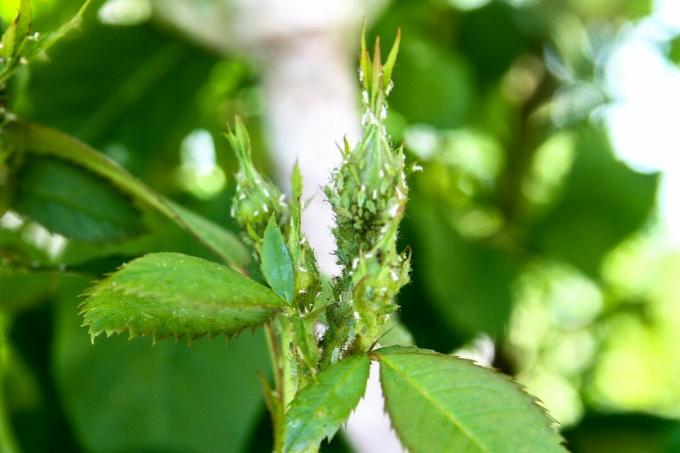
For now, try rinsing the rose with vigorous water pressure or wiping the aphids with a damp cloth. Neem oil-based products such as our purely vegetable one are particularly effective Plantura Organic Pest Free Neem. Other helpful tips for fighting Aphids on roses we have put together for you in our special article.
Identify and control rose sawfly
In the rose sawfly (Caliora aethiops) the larvae are the actual pests. The adult animals are shiny black with gray wings and reach a size of about five millimeters. From May, the females lay their eggs on the underside of the leaves. The larvae that hatch from them are green and yellow on the underside. These eat the leaf green only superficially, which is why one also speaks of window damage. In the case of a severe infestation, only a skeleton of the leaf often remains. Affected shoots should be removed as soon as possible. Regular pruning in the spring helps prevent it. Biological pesticides based on neem oil can help in later stages. Our purely vegetable Plantura Organic Pest Free Neem is a natural and extremely effective solution.

Recognizing and combating rosehoppers
The infestation with leafhoppers (Edwardsiana rosae) can be recognized by the white speckles on the upper side of the leaf. You will probably find tiny, light green insects on the underside of the leaves that suck the sap from the leaves. But don't be alarmed if the movement of the leaf causes the little cicadas to jump. To prevent rosehopper infestation, you should choose a location for your rose where the Insolation is not too strong and make sure your plants are supplied with sufficient nutrients give. More information about Rosehopper can be found in our special article.
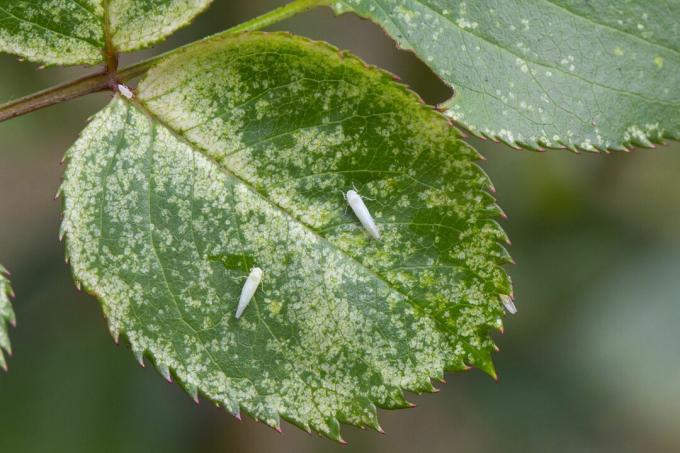
Recognize and combat rose leaf roller wasps
The rose leaf roller wasp (Blennocampa phyllocolpa) is most easily recognized by the distinctive damage pattern: leaves curled up downwards. The wasp itself is rather inconspicuous with a size of four millimeters. In warm regions, the symptoms are already visible from April, otherwise from May. In most cases, it remains with individual infested leaves and control is not necessary. In the case of a severe infestation, however, the plant is disfigured and growth inhibitions are visible. The rose sawfly larva resides inside the roll and migrates into the soil in August where it overwinters.
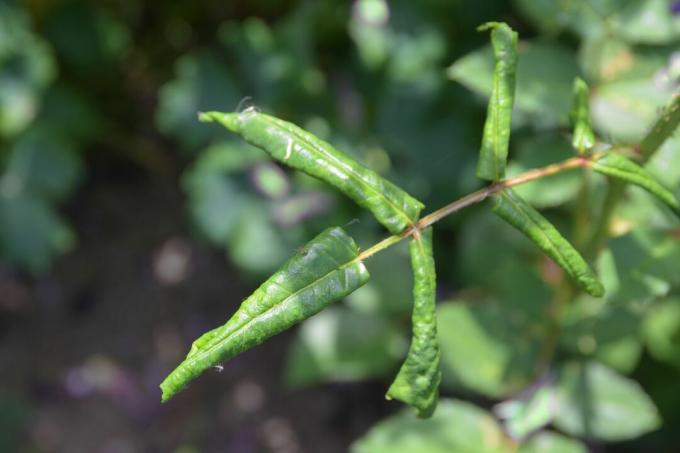
To combat and as a preventive measure, we recommend that you remove the affected leaves together with the caterpillar and dispose of them in the residual waste. Pesticides usually do not have a good effect because the caterpillar is well protected in the leaf roll.
Identify and control rose gall wasp
An infestation by the rose gall wasp (Diplolepis rosae) is easily recognizable by the very conspicuous galls. The galls are usually several centimeters in size and sit at the tip of the shoot. Hair-like, green, yellow or reddish colored outgrowths from the bile are very typical. From the end of May, such galls can appear on the roses. The plant will not suffer any significant damage from an infestation. The galls look unsightly in the first place and should be removed as soon as possible to prevent the pest from spreading.

Optimal fertilization is an important basis for resilient roses. In our article on the topic rose fertilizer learn all about fertilizing roses.



